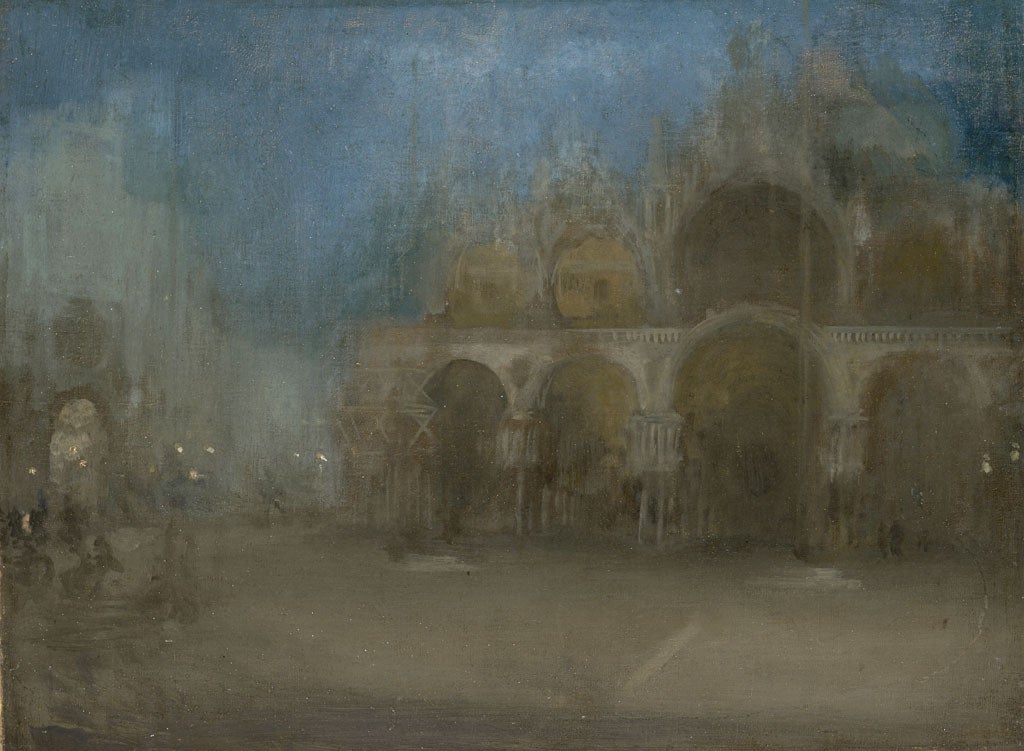Great Works: Nocturne: Blue and Gold, St Mark's Venice, 1879-80 (44.5cm x 59.7cm), James McNeill Whistler
National Museum Wales, Cardiff

Your support helps us to tell the story
From reproductive rights to climate change to Big Tech, The Independent is on the ground when the story is developing. Whether it's investigating the financials of Elon Musk's pro-Trump PAC or producing our latest documentary, 'The A Word', which shines a light on the American women fighting for reproductive rights, we know how important it is to parse out the facts from the messaging.
At such a critical moment in US history, we need reporters on the ground. Your donation allows us to keep sending journalists to speak to both sides of the story.
The Independent is trusted by Americans across the entire political spectrum. And unlike many other quality news outlets, we choose not to lock Americans out of our reporting and analysis with paywalls. We believe quality journalism should be available to everyone, paid for by those who can afford it.
Your support makes all the difference.You could say that the subject is far too much fussed over, known to too many, sobbed over by every right-thinking lover everywhere. And still the writers, the painters, the sketchers return, eager to make their own particular bond with the great, ruin-strewn theme-park that Venice is, and eager (in the case of the painters) to pocket the rewards for having done so. Whistler was there at the end of the 1870s. He tried not to go for the over-familiar sites. Instead, and for the most part, he chose the overlooked nooks and crannies.
For the most part, I say. Not on this occasion. This is San Marco, of course, almost at night, seeming to embody the wraith-like, Moorish mystery of the building's own fantasy of itself, and the painter's fantastical take on the presence of the building in this square. Many painters have stood further back from it or chosen to paint San Marco dead centre of the canvas in order either to give a triumphal symmetry to their evocation or to make it bulk more massively – John Wharlton Bunney, a disciple of Whistler's enemy John Ruskin, made such a painting (it's called St Mark's as It Looks in the Early Morning of a Sirocco Day) at the very time that Sickert was doing the one you can see on this page. Bunney, being a disciple of Ruskin, went to extraordinary lengths to capture the details of the building, to make sure that his painting was a faithful historical record painted at a very particular moment of the day. His painting was years in the making.
This San Marco of Whistler's is quite different. It is not very faithful. It is completely Whistlerian. While detail is not entirely lacking – look at the clusters of columns on the lower part of the facade, flanking the arches – Whistler's aim is not to preserve some kind of historical record. It is to create a mood, an atmosphere, to strike a long and harmonious chord in which past seems to merge with present in a kind of rhapsodic, dream-like state. Everything that is here – and there is so much that is not, including the great clock tower on the left of the basilica that has been smudged away to a kind of pale grey outline of itself, and the great horses above the central arch that Napoleon so rudely snatched away – is held here, suspended, in a kind of timelessness. Whistler was there to record the presence of mystery, to remind us that Venice is grounded upon almost nothing, risen up from water, and that it seems at times to be in a perpetual state of near-tragic dissolution.
San Marco seems to be creeping across to gain our attention, shuffling in stealthily from the right, under cover of that oncoming darkness. Not quite come on though. There is still a hint of light in the sky, and he has helped to render that with touches of pink, just as he has illuminated bits of the facade with snatches of white highlights. The falling light shrouds her, muffles her presence among us, which seems simultaneously to be both light and heavy. The brown-cum-gold roots the basilica in its own physical presence, pulls it earthward. The blues seem to tug it gently skyward, as if it might float away. We peer, further and further, into the dark void of its arches, and find nothing there but an every-thickening absence. Its ethereal presence can also be ascribed to the fact that it seems to be almost an after-image of itself when we look at it, something half-registered in the mind's eye. It is receding from us even as we scrutinise it. And yet in spite of all that, we do find ourselves filling in details for ourselves because we know it so well. We build a greater solidity for its presence here from everything that we already know.
ABOUT THE ARTIST
James McNeill Whistler (1834-1903) was an American painter who lived for the greater part of his life as a dandy in Europe. His paintings are about tonal relationships and the pursuit of harmony. A failed libel action against the independently wealthy John Ruskin in 1878 had a devastating effect.
Join our commenting forum
Join thought-provoking conversations, follow other Independent readers and see their replies
Comments